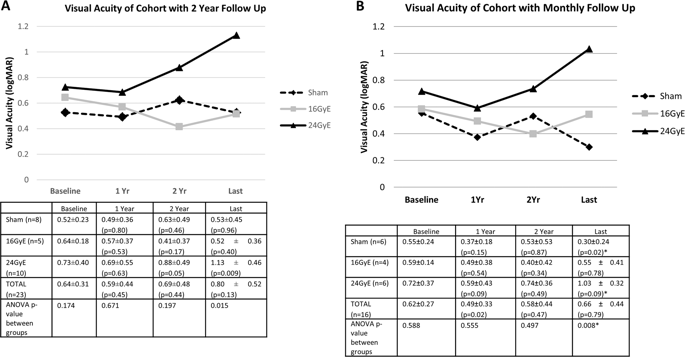Our official English website, www.x-mol.net, welcomes your
feedback! (Note: you will need to create a separate account there.)
Phase I/II randomized study of proton beam with anti-VEGF for exudative age-related macular degeneration: long-term results
Eye ( IF 2.8 ) Pub Date : 2020-02-13 , DOI: 10.1038/s41433-020-0807-2 Lekha K Mukkamala 1 , Kavita Mishra 2 , Inder Daftari 2 , Ala Moshiri 1 , Susanna S Park 1
Eye ( IF 2.8 ) Pub Date : 2020-02-13 , DOI: 10.1038/s41433-020-0807-2 Lekha K Mukkamala 1 , Kavita Mishra 2 , Inder Daftari 2 , Ala Moshiri 1 , Susanna S Park 1
Affiliation

|
Background/objective To determine if treatment of exudative age-related macular degeneration (eAMD) using proton beam therapy (PBT) combined with intravitreal anti-vascular endothelial growth factor (anti-VEGF) therapy is safe and effective long term. Subject/methods Thirty eyes with newly diagnosed eAMD were enrolled in a phase I/II prospective, sham-controlled double-masked university study. Eyes were randomized 1:1:1–24 GyE, 16 GyE or sham radiation, and treated with three initial monthly intravitreal ranibizumab or bevacizumab. Subsequent anti-VEGF reinjection was based on monthly optical coherence tomography and examination for 2 years and standard of care thereafter. Results A total of 23 eyes completed 2-year study follow-up, of which 16 maintained monthly follow-up. Mean best-correct visual acuity (BCVA) at 2 years was similar among treatment groups ( p > 0.05). The 24 GyE group required fewer anti-VEGF injections when compared with the sham group at 2 years (4.67 ± 1.9 vs 9.67 ± 3.5; p = 0.017). Extended follow-up (mean 4 years) available in 22 eyes showed persistent reduced need for anti-VEGF therapy among eyes treated with 24 GyE compared with sham radiation (2.0 ± 1.6 vs 4.84 ± 2.4 per year, p = 0.008). New and increasing geographic atrophy (GA), noted in some eyes in all treatment groups, resulted in decreased mean BCVA from baseline for the 24 GyE group on extended follow-up ( p = 0.009). Possible mild radiation retinopathy noted in 15% of eyes was not visually significant. Conclusions Initial treatment combining PBT (24 GyE) with intravitreal anti-VEGF therapy appears to decrease the need for anti-VEGF reinjection in eyes with newly diagnosed eAMD. Radiation retinopathy risk was low and does not appear visually significant. Long-term vision was limited by GA development especially in the 24 GyE group.
中文翻译:

质子束与抗 VEGF 治疗渗出性年龄相关性黄斑变性的 I/II 期随机研究:长期结果
背景/目的 确定使用质子束治疗 (PBT) 联合玻璃体内抗血管内皮生长因子 (anti-VEGF) 治疗渗出性年龄相关性黄斑变性 (eAMD) 是否长期安全有效。受试者/方法 30 只新诊断为 eAMD 的眼睛被纳入一项 I/II 期前瞻性、假对照双盲大学研究。眼睛按 1:1:1–24 GyE、16 GyE 或假放疗随机分组,并用最初的每月玻璃体内雷珠单抗或贝伐单抗治疗 3 次。随后的抗 VEGF 再注射基于每月光学相干断层扫描和 2 年检查以及此后的护理标准。结果共23眼完成2年研究随访,其中16眼维持每月随访。治疗组间 2 年平均最佳矫正视力 (BCVA) 相似(p > 0.05)。与假手术组相比,24 GyE 组在 2 年时需要更少的抗 VEGF 注射(4.67 ± 1.9 对 9.67 ± 3.5;p = 0.017)。22 只眼的延长随访(平均 4 年)显示,与假放疗相比,接受 24 GyE 治疗的眼对抗 VEGF 治疗的需求持续减少(每年 2.0 ± 1.6 对 4.84 ± 2.4,p = 0.008)。在所有治疗组的一些眼睛中都注意到新的和不断增加的地理萎缩 (GA),导致 24 GyE 组在延长随访中的平均 BCVA 从基线下降 (p = 0.009)。15% 的眼睛可能出现轻度放射性视网膜病变,但在视觉上并不显着。结论 将 PBT (24 GyE) 与玻璃体内抗 VEGF 治疗相结合的初始治疗似乎减少了新诊断的 eAMD 眼中抗 VEGF 再注射的需要。放射性视网膜病变的风险很低,并且在视觉上并不显着。长期视力受到 GA 发展的限制,尤其是在 24 GyE 组中。
更新日期:2020-02-13
中文翻译:

质子束与抗 VEGF 治疗渗出性年龄相关性黄斑变性的 I/II 期随机研究:长期结果
背景/目的 确定使用质子束治疗 (PBT) 联合玻璃体内抗血管内皮生长因子 (anti-VEGF) 治疗渗出性年龄相关性黄斑变性 (eAMD) 是否长期安全有效。受试者/方法 30 只新诊断为 eAMD 的眼睛被纳入一项 I/II 期前瞻性、假对照双盲大学研究。眼睛按 1:1:1–24 GyE、16 GyE 或假放疗随机分组,并用最初的每月玻璃体内雷珠单抗或贝伐单抗治疗 3 次。随后的抗 VEGF 再注射基于每月光学相干断层扫描和 2 年检查以及此后的护理标准。结果共23眼完成2年研究随访,其中16眼维持每月随访。治疗组间 2 年平均最佳矫正视力 (BCVA) 相似(p > 0.05)。与假手术组相比,24 GyE 组在 2 年时需要更少的抗 VEGF 注射(4.67 ± 1.9 对 9.67 ± 3.5;p = 0.017)。22 只眼的延长随访(平均 4 年)显示,与假放疗相比,接受 24 GyE 治疗的眼对抗 VEGF 治疗的需求持续减少(每年 2.0 ± 1.6 对 4.84 ± 2.4,p = 0.008)。在所有治疗组的一些眼睛中都注意到新的和不断增加的地理萎缩 (GA),导致 24 GyE 组在延长随访中的平均 BCVA 从基线下降 (p = 0.009)。15% 的眼睛可能出现轻度放射性视网膜病变,但在视觉上并不显着。结论 将 PBT (24 GyE) 与玻璃体内抗 VEGF 治疗相结合的初始治疗似乎减少了新诊断的 eAMD 眼中抗 VEGF 再注射的需要。放射性视网膜病变的风险很低,并且在视觉上并不显着。长期视力受到 GA 发展的限制,尤其是在 24 GyE 组中。











































 京公网安备 11010802027423号
京公网安备 11010802027423号